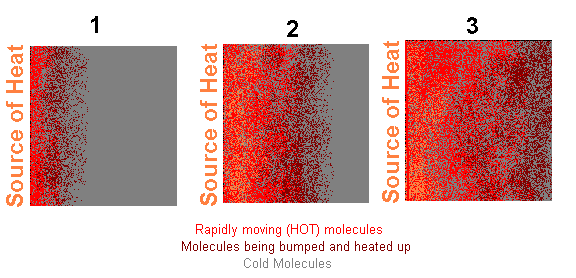Temperature SystemHow and why do we control heat on a spacecraft? |
Heat moves in three ways: Radiation, conduction, and convection.
Radiation happens when heat moves as energy waves, called infrared waves, directly from its source to something else. This is how the heat from the Sun gets to Earth. In fact, all hot things radiate heat to cooler things. When the heat waves hits the cooler thing, they make the molecules of the cooler object speed up. When the molecules of that object speed up, the object becomes hotter.

Infrared waves are part of a spectrum of energy waves known as the electromagnetic spectrum. The electromagnetic spectrum includes all kinds of energy that can travel in waves, including light, heat, x-rays, radio waves, ultraviolet waves and microwaves.

All of these kinds of waves contain a lot of energy. Also, they can all travel through deep space. That's why we can see sunlight from stars billions of light years away. The light from them radiates to us.
Conduction is another way that heat moves. Heat is a form of energy, and when it comes into contact with matter (Anything that you can touch physically) it makes the atoms and molecules move. Once atoms or molecules are moving, they collide with other atoms or molecules, making them move too. These, then bump into other molecules and make them move, too. In this way, the heat is transferred through matter.

Conduction is what makes the handle of a pot hot when only the bottom of the pot is touching the stove. The heat from the burner starts the molecules in contact with the burner start to move. Those molecules bump against others in the pot, which bump others, until all the molecules in the pot, including in the handle, are moving. When someone touches the pot handle, they feel the heat. The heat has moved from the burner to the cook's hand through conduction.
Conduction is an important way that heat travels in space, but only within a spacecraft. Since there is very little matter in deep space, heat cannot leave a spacecraft by conduction.
Convection is a very important way that heat moves on Earth, but is not very important in space. Convection happens when a substance that can flow, like water or air is heated in the presence of gravity. When air or water is in the presence of gravity, the gravity pulls all of it down. The bottom of the air or water becomes denser because it is pulled down and also pushed down by the weight of the molecules on top of it.

When there is heat at the bottom of this air or water, the air or water molecules in contact with the heat start to move, and the molecules spread apart. The heated air or water becomes less dense. It rises up until it gets to air or water with the same density as it has, and when it gets there, it pushes the air or water that was there out of the way. At the same time, new air or water fills the space that was vacated when the heated molecules rose up. The air or water that gets pushed out of the way falls down. This sets up a circular motion. Air or water is heated at the bottom, travels to the top, cools, gets denser, falls, is heated again and the whole cycle starts again. Convection does not occur in space because there is no gravity.

Ovens work by convection. The heating coils at the bottom of the oven heat
the air which climbs to the top, cools slightly, and falls down again. 
![]()
What is heat?
What could go wrong on DS1 if it gets too cold?
What could go wrong on DS1 if there's too much heat?
![]()
Will DS1 get heated directly by the Sun?
Does heat travel differently in space than it does on Earth?
What role does the Sun play in space missions like DS1's?
![]()
What other forms of energy does a spacecraft releases into space?
What makes EM radiation?
Where does energy come from and go?
What happens to the heat once it is released into space?
![]()